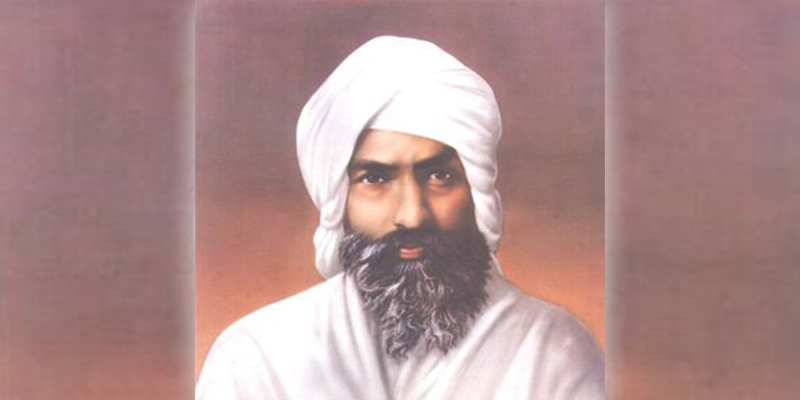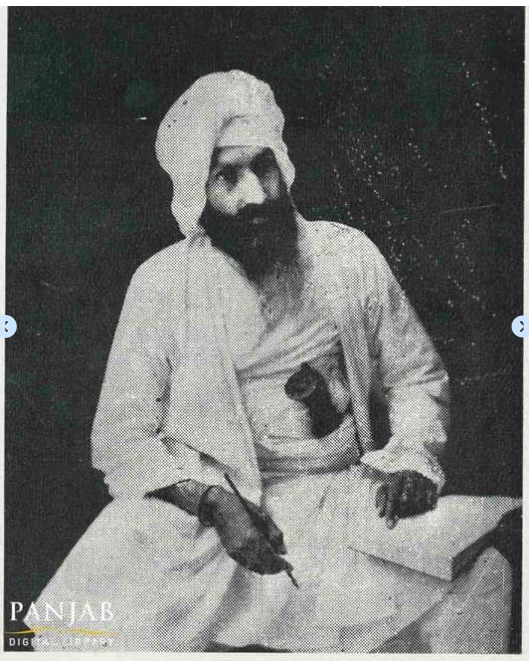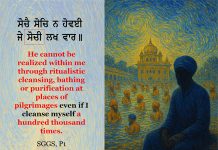
By Karminder Singh Dhillon | The Sikh Bulletin |
The first Sikh to be excommunicated by a decree of the Akal Takhat was Professor Gurmukh Singh, founder of the Sikh Reform Movement or the Singh Sabha Leher. His excommunication happened in 1887 in colonial Punjab.
What is worth noting is that his excommunication was never accepted by the Sikh masses, including the elite. The core sanction in an excommunication order is that Sikhs stop associating with the one who is excommunicated. This never happened to Gurmukh Singh. The enlightened Sikhs at that time such as Bhai Gurdit Singh, Gyani Ditt Singh and Bhai Kahn Singh Nabha defied the excommunication order and continued to deal and interact openly with Prof Gurmukh Singh.
Five reasons can be advanced for the fact that the excommunication of Gurmukh Singh failed to have the desired effect.
The first comes from within the philosophy of Sikhi Gurmat, and Sikh history. There is not a single verse within the Sri Guru Granth Sahib (SGGS) that supports the notion of excommunicating someone. From the Gurmat point of view, the act of excommunication goes against virtually every principle that Sikhs are supposed to inculcate – principles such as inclusion, a non-judgmental outlook towards others, and freedom of thought and belief. From the historical point of view, no Guru had advocated, preached or called for excommunicating anyone, let alone practice it. Sikhs did not think that Akal Takhat had the authority to go against such norms.
The second reason had to do with the nature of the charges against Prof Gurmukh Singh. It was clear that the root causes had to do with his ideas and activism relating to reform of Sikh practices. His basic contention that Sikhism had come to be corrupted in its practices and needed reforming had won the hearts and minds of the Sikh masses. His excommunication was thus viewed – by the Sikh masses – as an attempt to silence him and stop the reform in its tracks.
The third reason was that the concept of excommunication was alien to Sikhs. A vast majority believed that the notion had been infiltrated into Sikhism by the British colonialists who had a stellar record of interfering in the religious practices of Sikhs. The British viewed Sikhi as the root cause of their inability to subjugate Sikhs and had thus openly interfered in all matters concerning the Sikh religion. They had created a class a people called “Sants” to propagate a corrupted version of Sikhi, taken over control of the management of Sikh Gurdwaras, hired people to write versions of Sikh history that favored British domination, and co-opted Sikh leaders into their designs through acts of corruption. Getting the Akal Takhat to excommunicate influential Sikh leaders who did not want to serve British interests fitted well into their scheme of subjugation of their subjects.
READ ALSO: Excommunication and Sikhism: The case of Bhai Ranjit Singh Dhadriawala
The fourth reason had to do with the Sikh personalities who were believed to be the instigators and prime movers of the excommunication. Khem Singh Bedi who had mischievously set up the Snatani (vedic) branch of Singh Sabha Amritsar to hijack the reforms of the Singh Sabha Laher of Professor Gurmukh Singh had persuaded the masands and sarabrahs of Akal Takhat (caretakers hired by the British) to carry out the act of the excommunication. The Sikh masses were well aware of Khem Singh’s depravities – beyond his penchant for wanting to Snatanize Sikhi. He had claimed to be the direct decedent of Guru Nanak and considered himself to be the 11th Guru. He thus sat on a special cushion parallel to the SGGS in the Darbar Sahib.
The fifth reason had to do with the suspicion that the real reason behind Prof Gurmukh Singh’s excommunication was his vocal opposition to the Fareedkoti Teeka – the first ever exegesis of the Sri Guru Granth Sahib (SGGS) by a group of Benares based Nirmlas who had presented the SGGS as the “fifth Veyd”. The Singh Sabha leader has asked why Sikhs were not commissioned to the job. He asked Sikhs to reject the Teeka. The officially stated reason for the professor’s excommunication – disrespecting the SGGS and conducting activities against the Sikh Panth – was vague enough for the Gurbani enlightened Sikhs to surmise that his opposition to the Freedkoti Teeka was the real reason.
THE PRACTICE CONTINUES
The Akal Takhat nullified Professor Gurmukh Singh’s excommunication 108 years after the effect, in 1995. But it has carried on with the practice, even if in the absence of any clear basis of authority – either from the SGGS, Gurmat or Sikh historical practices.
Amongst those excommunicated since include Babu Teja Singh Bhassaur in the past century; and Professor Piar Singh, Gyani Bhag Singh Ambala, Gyani Gurbaksh Singh Kala Afghana, Prof Darshan Singh, Harnek Singh of Radio Virsa and Tharminder Singh Anand in more recent times. These good Sikh scholars were all excommunicated for their writings.
It is worth noting that at least three of those ex-communicated were either not residents of Punjab (Gyani Gurbakhs Singh was a resident of UK) or were citizens of foreign countries (Tharminder Singh is a citizen of the USA and Harnek a citizen of New Zealand) at the time of their excommunication. This raises the issue of jurisdiction. The institution of the Akal Takhat – the body that issues excommunication edicts – is administered by the SGPC. The SGPC is governed by The Sikh Gurdwaras Act, 1925. The jurisdiction of SGPC – and by extension the Akal Takhat – is thus limited to Punjab. Outside of Punjab its edicts are considered as advisory. This raises the question of validity of excommunication orders issues to Sikhs residing outside of Punjab.
POINTS WORTHY OF DELIBERATION
In summary then, the following seven points can be made.
One, the notion of “excommunication” does not exist within the Sikh scripture. It did not exist during the era of the ten Sikh Gurus (1469 – 1708). It did not exist in the post Guru period and the Sikh Raj period. It came to exist during British colonial rule.
Two, the Sikh clergy at Akal Takhat were exposed to the practice of excommunication when the British brought with them the tradition of Catholicism into Punjab.
Three the first excommunication order by the Akal Takhat was overturned by the same body more than a century later in 1995. This suggests that the Akal Takhat is aware of the illegitimacy of the practice.
Four, the institution of the Akal Takhat – as the body that issues excommunication edicts – is administered by the SGPC. The SGPC is governed by The Sikh Gurdwaras Act, 1925 which was a piece of legislation in British India which legally defined Sikh identity and brought Sikh gurdwaras under the control of an elected body of orthodox Sikhs. The jurisdiction of SGPC, and by extension that of the Akal Takhat outside of Punjab, or at least outside of India, is thus non-existant.
Five, a study of the main excommunications indicate that they are targeted against intellectuals, thinkers, academics and reform minded Sikhs. Such a fact raises serious questions regarding the intent of the practice. It appears that these excommunications are meant to act as a sword of Damocles to silence Sikhs who think, act and write differently from the version of the Sikh religion that is adopted by those who control the SGPC and the Akal Takhat.

Six, all five Jathedars of the Akal Takhat (and the 20 Jathedars of the other 4 Takhats) and all of the Granthis in the Takhats and Darbar Sahib are schooled in the Taksali, dera and sampardayi traditions. A study of those who have been excommunicated indicate they are either NOT from these traditions, or have, at some point in time, discarded these traditions. Such a situation raises serious questions regarding the selective nature of excommunications. Are they meant only for those who belong to traditions other than the Taksali, dera and sampardayi traditions? Tharminder Singh Anand is case in point. He was excommunicated for doing what the Dhumma faction and Nanaksar derawadis have done for decades – altering bani in their gutkas.

Seven, a study of complaints and call made to the Akal Takhat to “take action” against Sikh preachers in the past 5 years shows that 100% of them are made by people affiliated with the Taksali, dera and sampardayi traditions. Case in point is the complaints against Sikh preachers Professor Inder Singh Ghagga, Bhai Ranjit Singh Dhadreanwalla and Bhai Harinder Singh of Nirvair Khalsa Jatha. Such a situation raises the question of the institution of Akal Takhat and the excommunication process being used as a tool by Taksali, dera and sampardayi people against those parcharaks who belong to other traditions.
In the case of Professor Inder Singh Ghagga, Dhadreanwalla, and Harnek Singh, the assertion can be made that the root cause of their excommunication or other action by the Akal Takhat lay in the tensions that existed between those who propagate progressive interpretations of Sikh theology verses those who rely on orthodox ones. The assertion can also be made that the action taken against them by the Akal Takhat is, at its core, an instrument to silence them.

Sikh thinker, writer and parcharak Karminder Singh Dhillon, PhD (Boston), is a retired Malaysian civil servant. He is the joint-editor of The Sikh Bulletin and author of The Hijacking of Sikhi. This article appeared in the The Sikh Bulletin – 2023 Issue 3 (July – September 2023). Click here to retrieve archived copies of the bulletin. The author can be contacted at dhillon99@gmail.com.
RELATED STORY:
Excommunication and Sikhism: The case of Bhai Ranjit Singh Dhadriawala (Asia Samachar, 4 Sept 2020)
Grappling with Guru Granth printing errors. Thaminder takes the hit (Asia Samachar, 7 May 2022)
ASIA SAMACHAR is an online newspaper for Sikhs / Punjabis in Southeast Asia and beyond. When you leave a comment at the bottom of this article, it takes time to appear as it is moderated by human being. Unless it is offensive or libelous, it should appear. You can also comment at Facebook, Twitter, and Instagram. You can reach us via WhatsApp +6017-335-1399 or email: asia.samachar@gmail.com. For obituary announcements, click here

































